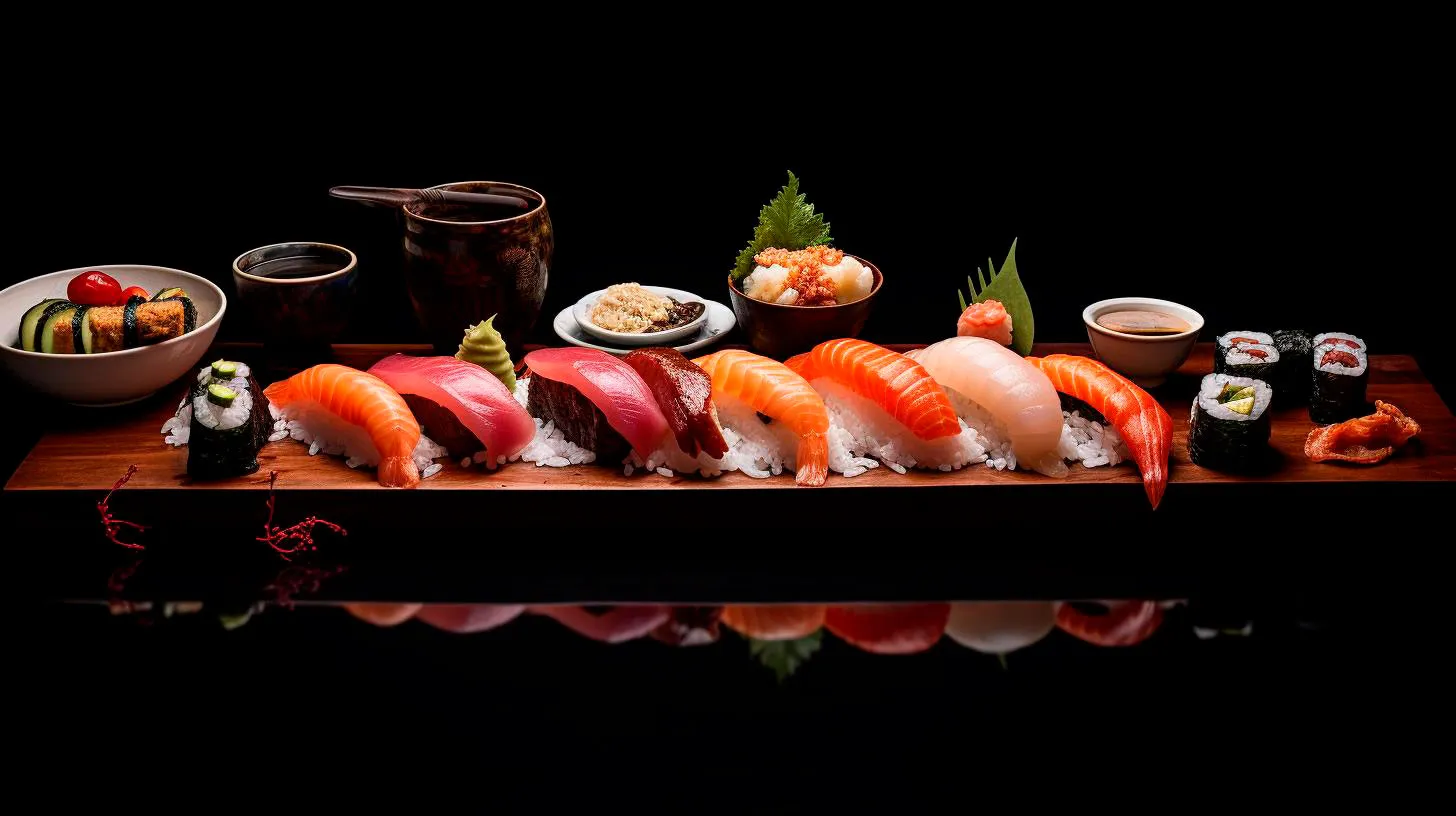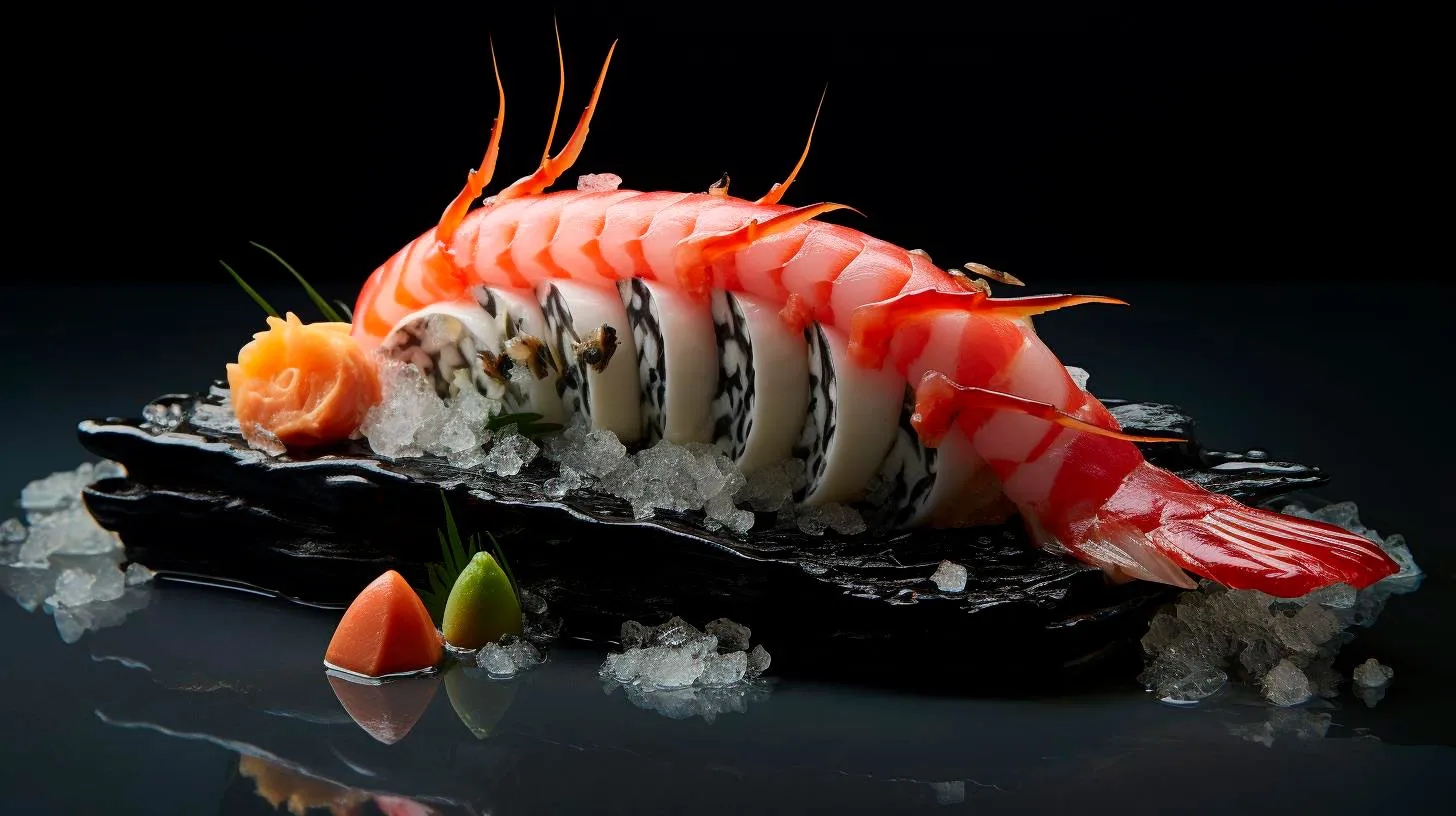Innovative Culinary Uses Beyond Sushi and Sashimi with Wasabi
Whether you’re a food enthusiast, professional chef, or simply intrigued by new flavors, exploring the many possibilities of incorporating wasabi into your cooking repertoire is sure to elevate your dining experiences.
The Unique Flavor of Wasabi
Before delving into the innovative culinary uses of wasabi, let’s first explore this exceptional ingredient. Wasabi belongs to the Brassicaceae family, which includes horseradish and mustard. Its prominent flavor profile is often described as pungent and spicy, with a distinct heat that dissipates quickly, leaving behind a refreshing coolness.
Most people are familiar with the green paste often served alongside sushi rolls, but true wasabi enthusiasts understand that the best flavor comes from fresh wasabi root. However, this rare delicacy can be quite expensive and difficult to find outside Japan. Thankfully, high-quality wasabi powders and pastes are widely available, providing a convenient alternative.
Innovative Uses of Wasabi
Now that we’ve established the unique qualities of wasabi, let’s explore some innovative ways it can be used in your culinary adventures:
1. Wasabi Mayonnaise
Combine mayonnaise with a touch of wasabi paste to create a delightful condiment that adds a zesty kick to sandwiches, burgers, or even as a dipping sauce for fries and vegetables. This creamy and spicy combination will leave your taste buds craving for more.
2. Wasabi Guacamole
Elevate your guacamole game by incorporating a small amount of wasabi paste. The heat from the wasabi beautifully complements the creaminess of avocados, resulting in a refreshing twist on this beloved dip. Serve it with tortilla chips or as a topping for grilled meats and seafood.
3. Wasabi Butter
Mix softened butter with wasabi paste to create a flavorful spread that pairs wonderfully with grilled steak, seafood, or roasted vegetables. The subtle heat of wasabi enhances the richness of butter, providing a unique taste sensation.
4. Wasabi Vinaigrette
Add a punch of flavor to your salads by incorporating wasabi into your vinaigrette. Combine ingredients such as olive oil, rice vinegar, soy sauce, honey, and a small amount of wasabi paste to create a tangy and slightly spicy dressing. Drizzle it over fresh greens or use it as a marinade for chicken or fish.
5. Wasabi Ice Cream
Yes, you read that right! Wasabi ice cream is a delightful treat that combines creamy sweetness with a subtle kick. The intense flavor of wasabi perfectly balances the sweetness of the ice cream, creating a unique dessert that is sure to impress your guests.
The Advantages of Using Wasabi in Your Cooking
Exploring innovative culinary uses of wasabi not only adds excitement to your dishes but also provides several advantages:
- Flavor enhancement: Wasabi’s bold and spicy kick elevates the taste of dishes, adding depth and complexity to your culinary creations.
- Unique dining experiences: Incorporating wasabi in unexpected ways surprises and delights your guests, offering them a truly memorable dining experience.
- Health benefits: Wasabi contains nutrients and compounds known to have antibacterial, anti-inflammatory, and antioxidant properties, contributing to overall well-being.
- Versatility: Wasabi can be used in both savory and sweet dishes, allowing for endless culinary experimentation.
Key Takeaways
Now that you’ve expanded your knowledge of wasabi beyond its traditional sushi accompaniment, let’s recap the key takeaways:
- Wasabi is a versatile and distinct ingredient known for its pungent flavor and heat.
- Experiment with wasabi by incorporating it into condiments like mayonnaise or guacamole.
- Try using wasabi in unexpected ways, such as flavored butter or vinaigrette.
- Don’t be afraid to explore the sweet side of wasabi with unique desserts like wasabi ice cream.
- Using wasabi in your cooking enhances flavors, creates unique dining experiences, and provides health benefits.
As you embark on your culinary adventures, remember to savor the distinct flavor of wasabi while experimenting with your own unique creations. Whether you’re a seasoned chef or a food enthusiast exploring new flavors in your kitchen, wasabi’s versatility is sure to inspire magnificent dishes that go beyond sushi and sashimi.
Exploring the Unique Flavor Profile and Health Benefits of Wasabi
The Flavorful Punch of Wasabi
Known for its intense heat and pungent aroma, wasabi is often described as one of the spiciest condiments out there. Its flavor profile is a unique blend of a sharp, peppery bite combined with a slight sweetness. When applied to foods, it provides an instant burst of heat that quickly dissipates, leaving behind a delightful tang on the taste buds.
Here are some key takeaways of the flavor profile of wasabi:
- Intense and pungent aroma
- Sharp, peppery bite with a hint of sweetness
- Instant burst of heat followed by a delightful tang
The Health Benefits of Wasabi
Aside from its distinctive flavor, wasabi also offers several potential health benefits. Rich in vitamins and minerals, this green paste may contribute to overall well-being and disease prevention. Let’s take a closer look at some of the potential advantages:
1. Antimicrobial Properties
Studies have suggested that wasabi possesses antimicrobial properties that could inhibit the growth of certain bacteria. This makes it a potentially beneficial condiment for improving gut health and reducing the risk of foodborne illnesses.
2. Potential Anti-inflammatory Effects
Certain compounds found in wasabi, such as isothiocyanates, have been shown to possess anti-inflammatory properties. These compounds may help lower the risk of chronic inflammation, which is associated with various health conditions including cardiovascular disease and cancer.
3. Rich in Antioxidants
Wasabi contains a range of antioxidants, including vitamin C and various phytochemicals. Antioxidants play a vital role in protecting our cells from damage caused by free radicals, which are unstable molecules that contribute to the development of various diseases and aging.
Now, let’s summarize the potential health benefits:
- Possesses antimicrobial properties for improved gut health
- Potential anti-inflammatory effects, reducing the risk of chronic diseases
- Rich in antioxidants, protecting against cellular damage and aging
Using Wasabi in Everyday Life
Wasabi doesn’t need to be limited to just sushi and sashimi. Its unique flavor can be incorporated into a wide range of dishes and culinary creations for an exciting twist. Here are some delicious uses for wasabi:
1. Wasabi Mayo
Add a zing of flavor to your sandwiches and burgers by mixing wasabi paste with mayonnaise. The creamy texture of mayo complements the spiciness of wasabi, creating a perfect balance of flavors.
2. Wasabi Dressing
Create a vibrant and tangy dressing by combining wasabi, soy sauce, rice vinegar, and a touch of honey. Pour it over your salads or use it as a dipping sauce for tempura to elevate your taste buds to new heights.
3. Wasabi Guacamole
Gently fold wasabi paste into mashed avocados to create a unique twist on classic guacamole. Serve it with tortilla chips or use it as a spread for sandwiches and wraps.
Here are some more tasty ideas to incorporate wasabi into your dishes:
- Wasabi-infused mashed potatoes
- Wasabi-spiced roasted nuts
- Wasabi-flavored popcorn
- Wasabi-marinated grilled shrimp
Embrace the versatility of wasabi and let your culinary creativity run wild!
In Conclusion
Wasabi is a condiment that offers a unique flavor profile and potential health benefits. Its intense heat and tang make it a favorite among food enthusiasts, while its antimicrobial and anti-inflammatory properties, along with its antioxidant content, contribute to overall well-being. With endless possibilities for incorporating wasabi into various dishes, it’s time to explore and savor the incredible flavors and potential health advantages this green paste has to offer.
The Origins of Wasabi and Its Importance in Japanese Cuisine
In this article, we will explore the origins of wasabi, its importance in Japanese cuisine, and its health benefits.
The History of Wasabi
Wasabi, scientifically known as Wasabia japonica, is a member of the Brassicaceae family, which also includes mustard, cabbage, and horseradish. Native to Japan, wasabi has a long history dating back thousands of years. It was first cultivated in mountainous regions, where the plant thrived in cool, shady conditions.
Initially, wasabi was used for medicinal purposes due to its antibacterial properties. Ancient texts suggest that it was consumed to treat digestive issues and respiratory ailments. Over time, culinary uses of wasabi emerged, and it became an integral part of Japanese cuisine.
Wasabi Cultivation and Production
Today, wasabi is primarily cultivated in three regions in Japan: Shizuoka, Nagano, and Iwate. The plant requires specific conditions to grow successfully. It thrives in mountainous areas with ample shade and clean water sources, making Japan an ideal location for cultivation.
The process of cultivating wasabi is labor-intensive and time-consuming. The plant is typically grown in gravel-filled beds called “sawa.” It takes about one to two years for the plant to reach maturity. The vibrant green rhizome, which is the prized part of wasabi, is grated into a paste just before consumption to preserve its flavor and pungency.
The Significance of Wasabi in Japanese Cuisine
Wasabi is widely used in Japanese cuisine, especially in sushi and sashimi dishes. Its distinctive flavor profile adds a unique and refreshing element to the overall taste experience. Here are a few reasons why wasabi is highly valued:
- Heat and Flavor: Wasabi provides a pungent and spicy kick that enhances the flavors of raw fish and other ingredients.
- Antimicrobial Properties: Wasabi’s antimicrobial properties help to prevent foodborne illnesses and extend the shelf life of raw seafood.
- Cultural Significance: Wasabi has been an integral part of Japanese cuisine for centuries, representing tradition and authenticity.
Health Benefits of Wasabi
Aside from its culinary uses, wasabi offers various health benefits. Here are a few notable advantages:
- Rich in Antioxidants: Wasabi contains antioxidants like isothiocyanates, which have been associated with reduced inflammation and oxidative stress.
- Anti-Inflammatory Properties: Consumption of wasabi has been linked to anti-inflammatory effects, potentially helping to alleviate symptoms of arthritis and other inflammatory conditions.
- Cardiovascular Health: Studies have suggested that the compounds found in wasabi may contribute to improved heart health by reducing the risk of blood clot formation.
Key Takeaways
Wasabi, with its vibrant flavor and intense heat, plays a vital role in Japanese cuisine. From its rich history to its health benefits, here are the key takeaways:
- Wasabi has been cultivated in Japan for thousands of years and was initially used for medicinal purposes.
- Today, wasabi is primarily grown in specific regions of Japan known for their optimal growing conditions.
- Wasabi adds a unique flavor and heat to Japanese dishes, particularly sushi and sashimi.
- It offers numerous health benefits, including antioxidant and anti-inflammatory properties.
So, the next time you savor a piece of sushi, take a moment to appreciate the humble yet powerful wasabi that elevates the taste and represents the rich traditions of Japanese cuisine.
Wasabi vs Horseradish Unraveling the Differences and Similarities
In this article, we will delve into the unique characteristics of these two spicy delights, highlighting their differences and similarities.
What is Wasabi?
First off, let’s start with wasabi. Originating from Japan, wasabi is a root vegetable primarily known for its vibrant green color and pungent flavor. Traditionally, wasabi is grated into a paste and served alongside sushi and sashimi. However, due to its scarcity and high production cost, real wasabi is a luxury that is often substituted with a cheaper alternative.
Key Features and Advantages of Wasabi:
- Authentic wasabi has a distinct, fresher flavor compared to its substitutes.
- Contains compounds with antimicrobial properties, making it beneficial for health.
- Provides a unique, spicy kick that enhances the taste of seafood and other dishes.
- Rich in vitamins, minerals, and antioxidants.
Despite its popularity, only a fraction of wasabi consumed worldwide is genuine. Most commercial wasabi products are made from a mixture of horseradish, mustard, and food coloring, giving them a similar taste and appearance.
What is Horseradish?
On the other hand, horseradish is a root vegetable that belongs to the Brassicaceae family. This fiery condiment is commonly used in various cuisines around the world, particularly in European and American dishes. Horseradish has a distinct, pungent flavor that can clear your sinuses in an instant.
Key Features and Advantages of Horseradish:
- Known for its potent heat, which can provide an intense flavor boost to dishes.
- Contains compounds that may offer antibacterial and anti-inflammatory benefits.
- Can act as a natural decongestant, providing relief from respiratory issues.
- Rich in essential nutrients like vitamin C, potassium, and calcium.
Horseradish is often used as a condiment for meats, sandwiches, and salads, providing a zesty and tangy flavor that complements a range of dishes.
Differences and Similarities
Differences:
- Origin: Wasabi is native to Japan, while horseradish has its roots in Europe.
- Appearance: Wasabi is known for its vibrant green color, while horseradish is white.
- Flavor: Real wasabi has a fresher, more herbal taste compared to the intense heat of horseradish.
Similarities:
- Both provide a spicy kick that adds flavor and depth to various dishes.
- Both contain compounds that offer potential health benefits.
- Both are root vegetables used as condiments in different culinary traditions.
Choosing the Right Culinary Spice
When it comes to selecting the perfect spice for your dish, several factors come into play. Consider the flavor profile you desire and the cuisine you are preparing. Real wasabi delivers a unique taste that pairs wonderfully with seafood, especially sushi. On the other hand, if you’re looking for a strong heat and bold flavor, horseradish is an excellent choice that can take your meals to the next level. It’s all about personal preference and the effect you want to achieve!
In conclusion, while wasabi and horseradish share some similarities, they are distinct in their flavors, origins, and culinary uses. Whether you opt for the authentic wasabi or the fiery horseradish, both of these spicy condiments are sure to elevate your dishes and awaken your taste buds.



